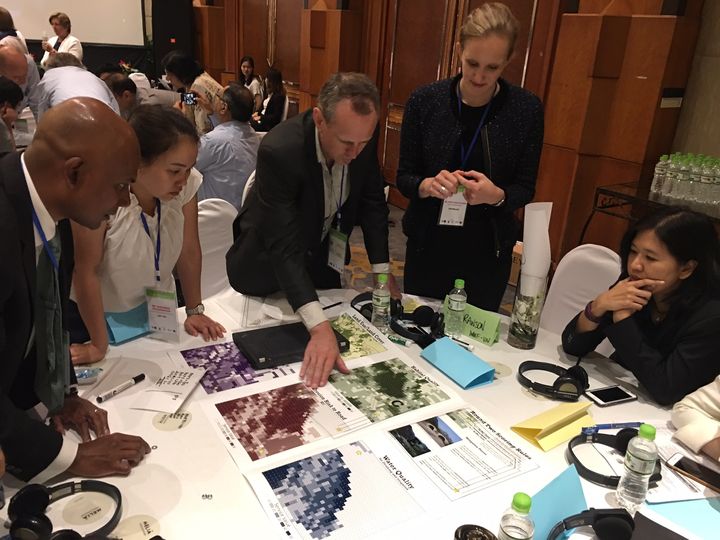“I’ve never been to an event like this in my career,” Swiss asset manager Dr. Barbara Weber told me on day two of the Hanoi International Forum on Sustainable Infrastructure. “Development Bankers, road ecologists, government planning officials, climate resilience specialists - all sitting together at one table! Remarkable.” Weber is the author of Infrastructure as an Asset Class, and the founder of B Capital Partners.
Why had they come to Hanoi?
“The world is facing a Tsunami of new transport infrastructure projects,” said keynote speaker Dr. William Laurance on stage the first morning. Laurance is a tropical ecologist at James Cook University, Australia and director of ALERT. Over a trillion dollars each year will soon be pouring into new roads and rail lines, said Laurance. Many of them will run though the world’s last remaining wilderness areas in Asia, Africa and Latin America - as well as landscapes already fragmented due to haphazard development.
The challenge the Hanoi forum addresses is how to build this infrastructure without eroding the ecological integrity of the land and rivers through which they will run. It’s much more than an environmental issue – deforestation, erosion, climate change, and interfering with endangered species can turn projects that seem profitable on paper into net loses for investors, insurers and governments.
Promod Das, Deputy CEO of RAM Ratings Agency and a panelist in the forum’s finance session, explained what needs to be done: “To ensure that all relevant and material risk factors are looked at, credit rating agencies, bankers and investors need to also look at the ecology, climate change and any other environment, social or governance factors that are currently visible or that could materially impact the project’s expected cashflow to meet its debt obligations or its return, in the future.” (For more, see RAM’s media release about the Hanoi Forum).
But this is not the way it usually happens - at least not yet.
“Getting it right at the start of these projects is the key,” said Dr. Rodney van der Ree, a road ecologist at Ecology and Infrastructure International and lead author of The Handbook of Road Ecology. “Environmental Impact Assessments are often finalized quite late in the project cycle, and usually after the budget has been set,” van der Ree told me. “So if there are cost overruns, officials tend to cut corners, and the environment suffers.”
Part of the problem is that the various experts are each trapped in their silos. One main goal of the Hanoi Forum has been to bridge those gaps, and get the experts talking to each other about how to finance and build crucial transport infrastructure without destroying the natural capital upon which all life – including human life – depends. I was able to interview two of the co-organizers of the forum, Bruce Dunn of the Asia Development Bank (ADB) and Kate Newman of the World Wildlife Fund (WWF) to find out more:
Q1: What did you hope to accomplish with the event?
Bruce Dunn & Kate Newman: Together with all our partners, we hoped to build-awareness and stimulate global collaboration on infrastructure designs that delivers benefits to people, while protecting wildlife and the climate.
Q2: Why did you decide to hold it in Viet Nam?
Newman: One of the co-hosts of the event is the Vietnam Institute of Strategy and Policy on Natural Resources and Environment (ISPONRE) within the Ministry of Natural Resources and the Environment. ISPONRE is at the forefront of research in Vietnam on integrating the value of natural ecosystems into national development planning, especially the development of new roads and rail across the country.
Dunn: Viet Nam is really taking leadership on sustainability issues. Laws are being put in place requiring the government to undertake environmental assessments of all major sector plans. And mechanisms are being created to channel revenues from infrastructure towards environmental protection. ADB has been helping the Government with these efforts, including recent work on the mapping and valuation of natural ecosystems to improve the sustainability of road planning.
Q3: How did you get the experts talking to each other?
Dunn: Normally these types of forums bring together experts to talk about finance, or climate change, or ecology. But they do it in different rooms and speak different languages. We wanted to bring them all together in one place, so they could begin speaking the same language and work together on integrated solutions. Here we used interactive approaches including a “Trade-Off Infrastructure” game developed by The Natural Capital Project at Stanford University to get experts talking to each other about solutions for infrastructure challenges.
Newman: The point of the game is to build a road over a geographic map connecting two towns. There are five pathways to choose from – straight through a wilderness area, along a riverbank, a big detour through open plains, etc. Each team gets points for spending the least to get the road built. But then in a second round, the ecological consequences are revealed, with points lost for roads that undermine the natural capital of the area by creating erosion, ruining watersheds, or destroying wildlife. The teams are given more detailed maps of the area and tools to make smarter choices. And then in a final round, the long-term impacts of climate change are revealed. This makes a powerful impression. You’ve got to plan for a future that will be different than today. As rainfall patterns and agriculture shift, so to does the best route for a road.

Hanoi Forum participants play “Trade-off Infrastructure”
Q4. What did you hear from participants that indicated you were reaching hearts and minds?
Dunn: The interactive features of the event were excellent. You could feel that the whole room was abuzz with questions and ideas. Best of all were the proposals that sprang-up organically. For example, the Wildlife Institute of India – who has recently developed guidelines for wildlife corridors – proposed collaboration to train a cadre of new “eco-road engineers” in South Asia.
Newman: On the finance side, we had groups such as RAM Ratings, a credit rating agency, and B Capital Partners, an infrastructure investment firm, talking about principles for incorporating environmental, social and governance risks into infrastructure designs. We believe having RAM Ratings – ASEAN’s leading credit rating agency – championing sustainable finance and infrastructure will have a catalytic effect.
Question 5. What was the final outcome of the Forum and what are the next steps?
Dunn & Newman: The forum was designed to develop “key principles” for making infrastructure more sustainable. While a range of topics were covered – from policy, planning, design and finance – the overwhelming consensus was that planning for infrastructure should start early, and at national and landscape scales, well before a specific project is initiated to allow for integrated, multi-sectoral priority setting. This involves a broad range of stakeholders, and should be informed by strategic environmental and climate assessments. We’re calling these the “Hanoi Principles for Sustainable Infrastructure.” Over the next one to two years we plan to flesh out and refine the principles while developing case studies and guidance materials that can help put them into practice.
It’s a long road ahead. But a green one.
Bruce Dunn is a Principal Environment Specialist with the Asian Development Bank in Manila. An ecologist by training, his mission is to help developing countries in Asia and the Pacific to address environmental sustainability and climate challenges as part of infrastructure planning and design.
Kate Newman specializes in large-scale conservation planning and national policy development to help maintain ecosystem services while enabling the stewards of ecosystems - local communities - thrive and prosper. As vice president for public sector initiatives at WWF US, Kate works with teams in Asia, Africa and Latin America to help connect science, policy and donor financing to advance conservation.
Tim Ward is the author of The Master Communicator’s Handbook.
Resources:
The Hanoi Forum website (and associated research documents)
Stanford University & partners: The Natural Capital Project
